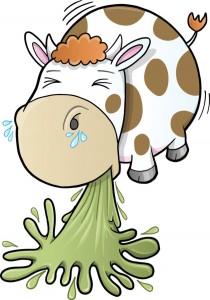The history of black mold, also known as stachybotrys chartarum, dates back to early civilization, with perhaps the earliest reference to mold being in the Bible. In Chapter 14 of Leviticus in the Old Testament, if mold was discovered on a stone of the wall inside a house, the stone was to be removed from the house and taken far away from the city. Any person who had eaten or lived in that house was required to bathe him or herself once the stone with mold was removed. When there were several stones with mold in the house, the structure was to be dismantled, with the stones taken far from the city. These days, while dismantling your home and removing the pieces with mold might still work, it’s not a very viable option and there are much less drastic measures one can take to make their home mold free. WHEW!!
Carl Joseph Corda, a Czech mycologist, first described the poisonous black mold in 1837 after he found it growing on the wall of a house in Prague. However, mold in Eastern Europe really took center stage later on in the 1930s when farm and barnyard animals — mostly horses — began dropping like flies (there were probably some flies dropping themselves as well). Several cases were reported of farm animals dying mysteriously from a strange, unknown disease. The symptoms of this mystery disease included infection, suppression of the immune system, nervous system disorder, bleeding and shock.
In 1938, a Russian scientist determined that the sickness was caused by black mold. Mold was growing on the hay and feed of animals, which had become damp due to rain and condensation. The disease was named stachybotryotoxicosis (sound familiar?). The discovery of black mold and its toxicity in the 1930s jumpstarted the study of black mold and gave it a prominent place in modern history. Many tests were carried out on animals with an aim of examining the toxicity of the black mold. Today, the disease occurs all over the world but still appears to be more frequent in Eastern Europe.
The first human infections were reported in the 1940s in Russia. Those affected by black mold were mainly farm workers. Remember that the animals were getting sick from wet feed and hay that was growing mold? Well farm workers soon started feeling the effects as well since they were in constant contact with the animals and their food. So if Old MacDonald did indeed have a farm, it was likely with some mold, mold, here and some mold, mold, there. And after a hard day’s work on the farm, if Old MacDonald experienced prolonged exposure to the mold, he could expect an uncomfortable evening indoors with possible bleeding, skin irritation, asthma, fatigue and fever. And let’s only hope that Mrs. MacDonald didn’t use any grains in her cooking that were infected with the black mold, or Old MacDonald’s more mild symptoms could become diarrhea, abdominal pain, nausea and vomiting.
While the early history of black mold was mostly related to agriculture, new building methods developed in the 1970s made it possible for black mold to grow and spread in homes. Following the energy crisis in 1970s, new building laws and codes were introduced. The codes made it mandatory for buildings to preserve energy by being airtight. Doesn’t sound too bad until you realize that airtight buildings meant buildings that were poorly ventilated, which allowed trapping of moist air for long periods of time. The use of cheaper construction materials like drywall, which is one of black mold’s favorite foods, also encouraged more mold growth.
Due to its toxicity, black mold has even been used in biological weaponry. It was first used in the Vietnam War in a biological weapon known as yellow rain. Yellow rain contained T-2 trichothecene mycotoxins from the black mold. The T-2 mycotoxins were also used in the Iraq-Iran war during Saddam Hussein’s rule. The Soviet Union was known to make biological weapons using materials from black mold. Although not confirmed, it is also believed that toxins from black mold caused the Gulf War syndrome.
Today, black mold can still be a problem in agriculture, but the development of binding agents used to remove mycotoxins and spores has greatly reduced the problem. Black mold also continues to be a major problem in many homes today.



